Transcendent Engineering
Giulio Prisco
This article was submitted for publication to the Journal of Personal Cyberconsciousness by Giulio Prisco, an Italian born futurist, transhumanist and IT/virtual reality consultant currently living in Hungary.
Giulio applies his insightful transhumanist and engineering vision to the crossroad of science and religion in that future technologies may create a pathway to resurrecting the dead.
In “Engineering Transcendence” [1] I argued that science may someday develop the capability to resurrect the dead and build (and/or become) God(s), and proposed to base a “transhumanist religion” [2] on this idea.
I also argued that the ultra-rationalist, aseptic engineering language dear to most transhumanists does not seem able to have an emotional impact on the majority of other people. This means that “traditional” transhumanist ideas will remain confined to a very small minority of technically oriented nerds, and never make a difference to the rest of humanity.
This is a pity as I think our ideas are beautiful and could give happiness, hope, a sense of wonder, purpose and peace of mind to a multitude of seekers. To do this, we must develop formulations and interpretations of transhumanism more emotionally appealing to persons with artistic and spiritual inclinations.
The “transhumanist religion” is addressed to persons with spiritual sensibilities and needs. It is designed to appeal to their sensibilities, and fulfill their needs, while at the same time remaining firmly grounded in the scientific worldview. Instead of “their”, I should of course say “our”: I am a person with spiritual sensibilities and needs. At the same time I am a physicist and an engineer by training and by inclination (and my worldview is strictly materialist), with no room for the supernatural. [See note 1 below]
I have been a member of the Extropy [3] mailing list since the late 90s. Ever since, the Extropy list has been one of my main sources of intellectual stimulation and enjoyment. I was also interpreting transhumanism in a spiritual sense at that time, and remember thinking of Extropy as a beautiful and powerful new religion for the new millennium. I also remember my very first post to the Extropy list, it was about the possibility of a technological resurrection of the dead; it received some encouraging replies.
“Engineering Transcendence” was not received enthusiastically by most transhumanists, but it was by some transhumanists and spiritually minded people. Over the years I continue to write about these things. I have refined my own thinking and have enjoyed the ongoing discussion (both online and face-to-face), with a small but growing group of like-minded persons.
The cornerstones of the transcendent engineering “religion” are:
-
Mind uploading --- someday it will be possible to transfer entire personalities from their original biological brain to more durable and powerful engineered substrates. [See Note 2 below]
-
Time-scanning --- someday it will be possible to acquire very detailed information from the past. Once time-scanning is available, we will be able to resurrect people from the past by “copying them to the future” via mind uploading. Note: time-scanning is not time travel, and it is free from the “paradoxes” of time travel. Time-scanning is just a form of archaeology --- uncovering the past by means of available evidence and records. Of course the very high definition form of time-scanning proposed here is orders of magnitude more powerful and sophisticated than archeology as we know it, but the concept is the same. [See Note 3 below].
-
Synthetic realities --- someday it will be possible to build artificial realities inhabited by sentient life. Perhaps future humans will live in synthetic realities. Perhaps we will wake up in a synthetic reality after having been copied to the future. Or… perhaps we are already there. [See Note 4 below]
-
Transcendent engineering offers not one, but two possibilities of resurrection: We may be copied to the future by our descendants by using time-scanning and mind uploading; or, we may already be living in a synthetic reality and the system admins may make a backup copy of interesting patterns every now and then. Hope in resurrection is, I believe, a necessary component of any effective alternative to traditional religions.
- If we live in a synthetic reality, then in a certain sense, we cannot even rule out the supernatural, or miracles. The simulators, the system admins, cannot violate their laws of physics, but they can violate our laws of physics if they want. It seems that the supernatural, which we have kicked out of the back door of superstition, may come back through the main door of science. [See Note 5 below]
”… reality may be much weirder than mythology.” I am the first to admit that this is a mythology and not a scientific theory. I believe it is a mythology compatible with rationality and the scientific worldview. Modern science says that reality, at a fundamental level, is much weirder than our simple, intuitive models, and lets us glimpse at vague and veiled shadows of wonderful things in heaven and earth. If anything, I am persuaded that reality may be much weirder than mythology.Many transhumanists with an ultra-rationalist approach have a very hard time considering parallels between transhumanism and religion. This is evident from the frequent discussions on mailing lists, blogs and Facebook comments. They don’t reply to arguments by saying things like “you are wrong because this thing you just said goes against scientific fact”, but take refuge in “you are wrong because this thing you just said sounds like religion”, which is not an argument. Of course, I can understand them; mistaken interpretations of religion have done great harm to many people, and I suspect most of them had a harmful religious upbringing and are so scared of getting close to religion again that they become blind to the good aspects of religion. Good interpretations of religion have done great good to many people, and following William James [4] I think a modern transhumanist religion, with religion’s contemplation of transcendence and hope in personal resurrection, but without its bigotry and intolerance, can be a powerfully positive force in the life of a person, which is what really matters.
I often call this transhumanist mythology “The Turing Church” [5], to emphasize the key role of substrate-independent mentality. The Turing Church is not an organization, but a meta-organization, mailing list and online meeting point for spiritually oriented transhumanists. The Turing Church’s mythology does not make a great difference in practice: we still live in a difficult and dangerous world, cancer still kills, we still age and die, there are still wars and atrocities, and billions of persons are still hungry, powerless, sick and unhappy. Contemplating the cosmic visions of the Turing Church gives me a sense of wonder and a sense of hope in a beautiful future... if only we can build it. It also gives me more motivation, energy and drive to try to give a small contribution toward making our world a better place.
After writing “Engineering Transcendence” I have become part of a small, but growing community of like-minded persons. I have taken the role of organizer of meetings in virtual reality spaces, first in Second Life [6] and then in ther next generation metaverses [7]. I’ve organized and participated in the organization of many virtual talks and conferences focused on transhumanist spirituality. The most recent was the Turing Church Online Workshop 1 [8], and other Turing Church Online Workshops are in preparation stages.
I have also joined three organizations focused on transhumanist spirituality: the Society for Universal Immortalism [9], the Mormon Transhumanist Association [10], and Terasem [11].
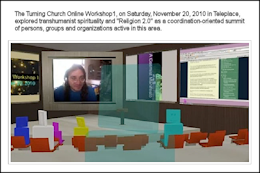
The Society for Universal Immortalism (SfUI) is a beautiful religion of hope and happiness, inspired by Mike Perry’s masterpiece “Forever for All” [12]; now available in full text on the Terasem website of Fred and Linda Chamberlain [13]. The Universal Immortalist program “we dedicate ourselves to finding a way one day to bringing back all persons that have ever lived, so that they can join us in our eternal adventure” says it all, but the Society has not been able to attract many members and supporters, perhaps because until recently, having a cryonic suspension contract has been a pre-requisite for membership. The Society has always kept a very low profile, very reasonable and soft-spoken (perhaps too), like those persons who are often right but nobody listens to because they don’t speak loud enough. I recently had the honor of being elected as President of the Society, and I will try to do something to change that.
”Man can and should become like God, and God was once limited like Man.” Though not a Mormon, I am an active member of the Mormon Transhumanist Association (MTA), which is one of the best and most active transhumanist communities. MTA members are only supposed to accept the Transhumanist Declaration and the Mormon Transhumanist Affirmation [14], and their New God Argument [15] resonates deeply with my own thinking. Lincoln Cannon and other MTA members claim that their transhumanist interpretation is perfectly compatible with standard Mormon doctrine, which includes the thesis, “Man can and should become like God, and God was once limited like Man.” I doubt that a majority of Mormons would agree with this position, but the MTA actively promotes transhumanism in the mainstream Mormon community, and is the best and most successful transhumanist group established within a major religion. I think both the strength and weakness of the MTA are in its integration in the Mormon community: the MTA is in a very good position to promote transhumanism in Mormon circles, but I doubt it will ever attract many non-Mormons. I look forward to seeing other successful transhumanist groups within major religions but perhaps, as Lincoln says, “Mormonism is an especially fertile ground.”
Last October I had the honor to give a (remote) talk at the Transhumanism and Spirituality Conference in Salt Lake City, organized by the MTA. My article “In Whom we live, move, and have our being” inspired the talk [16]. The slides from my presentation are available online. Recently, a great dialogue transpired between Ben Goertzel and Lincoln Cannon, entitled “Mormonism: The Most Transhumanist Religion?” [17], which was published in H+ Magazine; read it for some really fascinating insight on Mormonism, transhumanism, spirituality, and religion.
Both the SfUI and the MTA have central, “official” websites. On the contrary Martine Rothblatt’s Terasem, “A Transreligion for Technological Times” [18], has a more distributed and almost chaotic online presence. At this moment the most active Terasem website is the “Truths of Terasem Podcasts” [19] blog maintained by Fred and Linda Chamberlain, but by the time you read this another Terasem website may have taken the lead. In the blog, Fred and Linda (who are, among other things, the two founders of Alcor [20] explain and comment the concise and almost hermetic foundational text “The Truths of Terasem” [21]. See [Chamberlain 2010] and [TuringChurch 2010] below for a fascinating, first person account of the “cosmic download” of Terasem into Martine Rothblatt’s mind.
I have been associated with Terasem for a few years, and recently I formally joined. I think the nice and warm new-age look and feel of Terasem is our best chance to build bridges to the very large, scattered communities of spiritually oriented persons. Terasem offers a formulation and interpretation of transhumanism more emotionally appealing to persons with artistic and spiritual inclinations, which will help communicating our beautiful ideas in a simple and effective format and give happiness, hope, a sense of wonder, a sense of purpose and peace-of-mind to a multitude of seekers.
Ultra-rationalist “bureaucrats of philosophy” usually dismiss “hippie new-age attitudes”, but we should not forget that the hippie new-age attitude of the 60s shaped the Internet technology revolution [22]. Perhaps we had the right attitude in the beautiful, visionary anti-authoritarian 60s, and we should recover it to shape new transhumanist technology revolutions. My experience with new-agers is that, yes, they are easily deluded or scammed, and yes, they move from a guru to a new guru and from crystals to pyramids, but they are intellectually and spiritually alive, perhaps more alive and awake than others; seekers of something beautiful that they cannot define. I look forward to Terasem bridging the gap between the 60s and the 10s, cosmic visions and technology, spirituality and transhumanism.


 MTASfUITerasem
MTASfUITerasem“Space-time engineering and future magic will permit achieving, by scientific means, most of the promises of religions... All three groups mentioned above affirm the possibility of technological resurrection; the MTA and the SfUI very openly. We can find it also in the Truths of Terasem, for example: “Souls of our ancestors come back to life when we emulate their lives and their environment” [23]. In his great Cosmist Manifesto [24], Ben Goertzel endorses the possibility of technological resurrection by including the Ten Cosmist Convictions that we have co-authored, in particular “Space-time engineering and future magic will permit achieving, by scientific means, most of the promises of religions --- and many amazing things that no human religion ever dreamed. Eventually we will be able to resurrect the dead by ‘copying them to the future’ “ and more subtly in other passages. I had fascinating discussions with Ben and many others on specific technologies for resurrection (Perhaps there are micro wormholes permeating the fabric of space-time and connecting each space-time pixel with every other space-time pixel, which could be used for time-scanning; perhaps quantum entanglement across time; perhaps something else?). We probably can’t even begin to imagine a detailed solution. My answer to the question “Do you believe in an afterlife?” (within a recent Facebook poll) is very simple: Time will tell.
I concluded Engineering Transcendence with a call to arms: “I would support developing a strong, religious formulation of transhumanism as a front-end for those who need one.” Some quasi-religious interpretations of transhumanism have been developed, as outlined above, and documented by Robert Geraci in his book Apocalyptic AI [25].
Geraci defines Apocalyptic AI as a modern cultural and religious trend originating in the popular science press:
“Popular science authors in robotics and artificial intelligence have become the most influential spokespeople for apocalyptic theology in the Western world... Apocalyptic AI advocates promise that in the very near future technological progress will allow us to build supremely intelligent machines and to copy our own minds into machines so that we can live forever in a virtual realm of cyberspace... Ultimately, the promises of Apocalyptic AI are almost identical to those of Jewish and Christian apocalyptic traditions. Should they come true, the world will be, once again, a place of magic.”
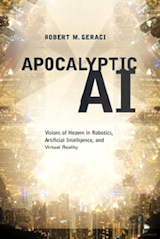 According to Geraci, Apocalyptic AI is a religion: a religion based on science, without deities and supernatural phenomena, but with the apocalyptic promises of religions. And he thinks that, while the Apocalyptic AI religion has a powerful but often hidden presence in our culture, the Transhumanist community embraces it openly and explicitly. Transhumanism is first defined as “a new religious movement”, and throughout the book Geraci continues to see it as a modern religion.
According to Geraci, Apocalyptic AI is a religion: a religion based on science, without deities and supernatural phenomena, but with the apocalyptic promises of religions. And he thinks that, while the Apocalyptic AI religion has a powerful but often hidden presence in our culture, the Transhumanist community embraces it openly and explicitly. Transhumanism is first defined as “a new religious movement”, and throughout the book Geraci continues to see it as a modern religion.I prefer not to define transhumanism as a religion; first because it wouldn’t be correct, and second because I don’t want to lose all my transhumanist friends. What all transhumanists have in common is the conviction that using advanced technologies to radically change the human condition is both feasible and desirable. Within this broad definition there are many possible interpretations of transhumanism, and one of these interpretations is the Turing Church mythology, or Apocalyptic AI.
Notes & Comments
[1] This is also the position of evolutionary biologist Richard Dawkins who, in a recent interview with the New York Times [26], said “it’s highly plausible that in the universe there are God-like creatures.”
In his book “The God Delusion” [27], Dawkins said:
“There are very probably alien civilizations that are superhuman, to the point of being god-like in ways that exceed anything a theologian could possibly imagine... As Arthur C. Clarke put it, in his Third Law: 'Any sufficiently advanced technology is indistinguishable from magic'."
“In what sense would they be superhuman but not supernatural? In a very important sense, which goes to the heart of this book. The crucial difference between gods and god-like extraterrestrials lies not in their properties but in their provenance. Entities that are complex enough to be intelligent are products of an evolutionary process. No matter how god-like they may seem when we encounter them, they didn't start that way. Science fiction authors . . . have even suggested (and I cannot think how to disprove it) that we live in a computer simulation, set up by some vastly superior civilization. But the simulators themselves would have to come from somewhere. The laws of probability forbid all notions of their spontaneously appearing without simpler antecedents. They probably owe their existence to a (perhaps unfamiliar) version of Darwinian evolution...”
Dawkins' position is similar to mine, and very clear: he rejects the “supernatural,” but he acknowledges no limit to the evolution of civilizations in the physical universe and their technologies, and he is open to the possibility of civilizations (perhaps including our own) attaining God-like powers at a certain point in their evolution. Yet, his attitude may be criticized by some of his “New Atheist” followers as too accommodating toward religion. I often find New Atheists’ “New Bigotry” annoying, and using the ideas of their Commander-in-Chief in support of my own gives me a certain perverse pleasure.
[2] I am persuaded that the ultimate realization of the dream of achieving an indefinite lifespan, with vastly enhanced cognitive abilities, lies in leaving biology behind and moving to a new, post-biological, cybernetic phase of our evolution. Mind uploading, the transfer of a human mind, memories, personality and “self” (whatever self” is) to new high performance substrates, is the ultimate technology for immortality. Therefore I have always been interested in mind uploading and I consider it as the “Holy Grail” of transhumanism: let our minds break free of our biological brains and bodies, and we will be free to roam the universe and grow beyond limits as software angels.
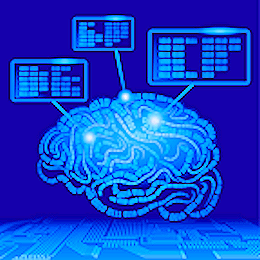
Once we develop the technology to transfer human minds to computer systems, uploaded minds will have many different post-biological embodiment options to interact with the rest of the world. Some uploads will choose to live in robotic bodies or synthetic biological bodies similar to our current bodies, but with vastly enhanced capabilities. For example, those who want to explore space will be able to choose rugged bodies able to endure the conditions of space. Other uploads will choose to live as pure software without a permanent physical body.
I am persuaded, that within a few decades, we will develop operational technologies for destructively scanning biological brains in such a way as to retain enough information for future re-instantiation of the mind. Of course, non-destructive scanning would be much better, but experts disagree on its possible timeline, and even feasibility in principle. I prefer to keep an open mind and, since non-destructive, very high resolution brain scanning seems feasible in principle that it is compatible with the laws of physics and so it is just another engineering problem, I tend to think it will be achieved sooner or later.
Another possibility is the Bainbridge-Rothblatt “soft” approach: we can create a “lifelogging” database with blogs, pictures, videos, answers to personality tests, etc. (see the CybeRev and LifeNaut projects of Martine Rothblatt [Rothblatt 2009]) [28], hoping that some future AI technology may be able to merge the information in the database with suitable “human firmware” (me-program) and bring it to life. I think this approach is basically feasible in principle, but needs data transfer rates from brain to computer storage much faster than we can achieve today. See my interview with Natasha Vita-More [29] for more.
[3] Time-scanning is often called “Quantum Archaeology”, based on the possibility that the best technologies for time-scanning may be based on weird quantum effects such as past-to-future entanglement; no one really knows, so I prefer using a less specific term.
In “The Physics of Immortality” [30] Frank Tipler describes how future intelligent beings may steer the gravitational collapse of the universe (the so called Big Crunch) in such a way as to have unlimited subjective time, energy, and computational power available before reaching the final singularity (Omega Point). Having done so, they may wish to restore to consciousness all sentient beings of the past, perhaps through a “brute force” computational emulation of the past history of the universe. After death we may wake up in a simulated environment with many of the features assigned to the afterlife by the major religions.

Since Tipler's “Heaven” where we will be resurrected is a simulated world, his is a special case of the synthetic realities scenario, which identifies the civilization running the simulation: they are our descendants at the end of time, with perhaps only a couple of seconds of objective time left, but an infinite span of subjective time and computing power.
"...someday science and technology may resurrect the dead." Tipler proposed a specific and detailed Omega Point theory, which has attracted a lot of criticism. But critics miss the point: perhaps Leonardo's aircraft sketches would not have been able to fly (the knowledge needed to design a flying machine was just not available at his time), but this does not lessen the value of Leonardo's insight that a device conceptually similar to his own sketches would someday fly. Similarly, we do not know enough physics and mathematics to assess specific Omega Point theories, but this does not lessen the value of Tipler's insight: someday science and technology may resurrect the dead.Science fiction writers proposed some of the most suggestive time-scanning and resurrection scenarios. In “The Light of Other Days” [31], Sir Arthur C. Clarke (who else?) and Stephen Baxter imagine a near future world profoundly transformed by the invention of a “Wormcam”: a remote viewing device that permits scanning any location at any time, including in the past, by using micro wormholes naturally embedded with high density in the fabric of space-time (every space-time pixel is connected with every other space-time pixel). Soon engineers are able to resurrect the dead:
“It was possible now to look back into time and read off a complete DNA sequence from any moment in an individual's life. And it was possible to download a copy of that person's mind and, by putting the two together, regenerated body and downloaded mind, to restore her... We live on Mars, the moons of the outer planets, and we're heading for the stars. There have even been experiments to download human minds into the quantum foam... We intend to restore all human souls, back to the beginning of the species. We intend to put right the past, to defeat the awful tragedy of death in a universe that may last tens of billions of years.”
[4] The “intelligence” of simulated characters (NPC) in computer games is still light years behind real intelligence. However, I am persuaded that real, self-aware AI of human and higher-level will be achieved someday, perhaps by the computer gaming industry itself, and perhaps in the next couple of decades. Then, computer games will contain sentient, intelligent persons like you and I.
If computer game characters can be intelligent and sentient, perhaps we are sentient and intelligent computer game characters. Do we live in a computer simulation? This is a frequent discussion topic in transhumanist interest groups. Who is running the simulation? Perhaps unknowable aliens in another level of reality have invented our world and us. A frequent assumption is that future humans run our reality as a historically accurate simulation of their past (our present).
Within a 1992 essay entitled, “Pigs in Cyberspace” [32], Hans Moravec formulated (in modern terms) the idea of our reality as a simulation:
“An evolving cyberspace becomes effectively ever more capacious and long lasting, and so can support ever more minds of ever greater power. If these minds spend only an infinitesimal fraction of their energy contemplating the human past, their sheer power should ensure that eventually our entire history is replayed many times in many places, and in many variations. The very moment we are now experiencing may actually be (almost certainly is) such a distributed mental event, and most likely is a complete fabrication that never happened physically.”
By “almost certainly is” Moravec refers to the idea that observers living in simulated realities may vastly outnumber observers living in original physical realities.If those who live in a simulated reality can themselves simulate lower level realities, perhaps upper case Reality is nothing more than an infinite cascade of realities simulated within higher-level realities (dreams within dreams, or turtles all the way down). This may well be the simplest explanation of the world, since assuming an infinite regress permits doing without a “base reality” which generates all other realities.
[5] A computer able to simulate a reality as complex as ours, inhabited by conscious observers, must be much more complex and powerful than any computer that we can imagine today, and it would likely be fully self-aware. So if we are living in a simulation, the computational system simulating our reality is not a what, but a who. Not an inanimate machine, but a thinking and feeling person, orders of magnitude smarter and more complex than us. We don't live in a mere machine, but in a Transcendent Mind. The last chapter of Hans Moravec's “Robot - Mere machine to Transcendent Mind” [33] has a fascinating preview of super-intelligent, human-AI hybrids spreading to the universe as “Mind Fire” and holding entire simulated realities in their vast minds.
Berkeley thought that the reality we perceive, and ourselves in it, exist in the mind of “that supreme and wise Spirit, in whom we live, move, and have our being”: God. In other words, we are thoughts in the Mind of God. It is easy to see that Berkeley and Moravec say very similar things, each in the language of his philosophy and age.
Apparently, there is an important difference between Berkeley and Moravec: As a 18th century Christian and a representative of the Church, Berkeley believed in supernatural phenomena, in principle not understandable by science, while Moravec, as a modern engineer, believes reality is fully understandable and explainable by science. Future engineers within the framework of future science will develop Moravec’s simulated realities. If our reality is a simulation, everything in our universe can be understood in terms of the physical laws of the higher-level reality in which it is simulated.
But... this does not mean that it must always be understandable in terms of our own physical laws: Moravec's simulation cosmology may contain supernatural phenomena, because the reality engineers up there may choose to violate the rules of the game. Yes, as Dawkins says [1] they are creatures naturally evolved in their physical universe and they cannot violate their physics, but they can violate ours if they want.
Make this simple experiment: Run a Game of Life program, choose an initial pattern, and let it evolve for a while. Now, stop the program, flip a cell, and resume the program. You have just performed a miracle: something that goes against the physical laws (the simple cellular automata evolution rules of Life) of the lower-level reality that you are simulating. Of course the Game of Life is too simple to contain conscious observers, but hypothetical observers within the game would observe an event that cannot be understood in terms of the physical laws of their universe. A miracle.
Berkeley and Moravec are not only saying similar things, they are saying the same thing using different wording. Moravec's “Transcendent Mind” is, by definition, omnipotent (all powerful), omniscient (all knowing), and omnipresent (always and everywhere present) in the simulated reality He thinks. He is Berkeley's “supreme and wise Spirit, in whom we live, move, and have our being”, a God. Perhaps the Mind hears our prayers, and sometimes answers them with a miracle; including the greatest miracle, resurrection.
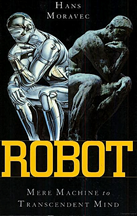
According to our best scientific understanding, it seems that the dead stay dead, but if we live in a simulation, the Mind can copy us before we die and paste us in a new, perhaps better simulation.
Endnotes
____________________________
[1] Prisco 2004 - Giulio Prisco, Engineering Transcendence,
http://giulioprisco.blogspot.com/2006/12/engineeringtranscendence.html[2] Transhumanism - Often abbreviated as H+ or h+, is an international intellectual and cultural movement that affirms the possibility and desirability of fundamentally transforming the human condition by developing and making widely available technologies to eliminate aging and to greatly enhance human intellectual, physical, and psychological capacities.
http://en.wikipedia.org/wiki/Transhumanist October 5, 2011 12:35PM EST[3] Extropy – "…[A] networking ideas exchange devoted to developing strategies for the future. Extropy is a symbol for continued progress and reflects the extent of a living or organizational system’s intelligence, functional order, vitality, and capacity and drive for improvement.”
http://www.extropy.org/About.htm October 5, 2011 12:52PM EST[4] James 1896 - William James, The Will to Believe,
http://educ.jmu.edu//~omearawm/ph101willtobelieve.html October 5, 2011 1:01PM EST[5] Goertzel 2011 - Ben Goertzel, Technological Transcendence: An Interview with Giulio Prisco,
http://hplusmagazine.com/2011/02/08/technological-transcendence-an-interview-with-giulio-prisco/ October 5, 2011 1:17PM EST[6] Second Life - a free 3D virtual world where users can socialize, connect and create using free voice and text chat.
http://secondlife.com/ October 5, 2011 1:15PM EST[7] Metaverse – “[A] collective online shared space, created by the convergence of virtually enhanced physical reality and physically persistent virtual space, including the sum of all virtual worlds, augmented reality, and the internet. The word metaverse is a portmanteau of the prefix "meta" (meaning "beyond") and "universe".”
http://en.wikipedia.org/wiki/Metaverse October 5, 2011 11:03AM EST[8] Turing Church - Turing Church Online Workshop 1, Teleplace, Saturday November 20,
http://telexlr8.wordpress.com/2010/11/21/turing-church-online-workshop-1-teleplace-saturday-november-20/ October 5, 2011 11:03AM EST[9] Society for Universal Immortalism (SfUI) – “The Society is organized to make known the ideals of the Society and to carry out its sacred, eternal mission. The Society has its historical roots in Religious Humanism, Religious Transhumanism, and The Society for Venturism, and continues their belief in reason inspired by love for humanity and the practical quest for a better life for all.”
http://www.universalimmortalism.org/about.htm October 5, 2011 1:25PM EST[10] Mormon Transhumanist Association – "[A]n international nonprofit organization that promotes practical faith in human exaltation through charitable use of science and technology.
http://transfigurism.org/pages/about/ October 5, 2011 2:20PM EST[11] Terasem - Terasem Movement, Inc. is a 501c3 not-for-profit charity endowed for the purpose of educating the public on the practicality and necessity of greatly extending human life.
http://www.terasemcentral.org/ October 12, 2011 3:22PM EST[12] Perry 2000 - R. Michael Perry, Forever For All,
http://truthsofterasem.wordpress.com/forever-for-all/ October 5, 2011 1:30PM EST[13] Chamberlain 2010 - Podcast No. 22 on The Truths of Terasem,
http://truthsofterasem.wordpress.com/2011/01/06/podcast-no-22-posted-on-itunes-12272010/ October 5, 2011 1:32PM EST[14] MTA 2006 - Mormon Transhumanist Affirmation,
http://transfigurism.org/pages/about/mormon-transhumanist-affirmation/ October 5, 2011 2:06PM EST[15] Cannon 2010 - Lincoln Cannon and Joseph West, The New God Argument,
http://lincoln.metacannon.net/2010/03/revised-summary-of-new-god-argument.html October 5, 2011 2:06PM EST[16] Prisco 2010 - Giulio Prisco, In Whom we live, move, and have our being,
http://giulioprisco.blogspot.com/2010/03/in-whom-we-live-move-and-have-our-being.html October 5, 2011 2:12PM EST[17] "Mormonism: The Most Transhumanist Religion?" H+ Magazine article:
http://hplusmagazine.com/2011/05/09/mormonism-the-most-transhumanist-religion/ October 5, 2011 2:32PM EST[18] Rothblatt 2010 - Martine Rothblatt on Reconstructing Minds from Software Mindfiles, Teleplace, September 18, http://telexlr8.wordpress.com/2010/09/18/martine-rothblatt-on-reconstructing-minds-from-software-mindfiles-teleplace-september-18/ October 5, 2011 2:32PM EST
[19] Truths of Terasem Podcast/Blog (Fred and Linda Chamberlain)
http://truthsofterasem.wordpress.com/ October 5, 2011 2:40PM EST[20] Alcor Life Extension Foundation – "[T]he world leader in cryonics, cryonics research, and cryonics technology.
http://www.alcor.org/AboutAlcor/index.html October 5, 2011 2:45PM EST[21] Chamberlain 2010 - Podcast No. 22 on The Truths of Terasem,
http://truthsofterasem.wordpress.com/2011/01/06/podcast-no-22-posted-on-itunes-12272010/ October 5, 2011 2:48PM ESTTuring Church - Turing Church Online Workshop 1, Teleplace, Saturday November 20,
http://telexlr8.wordpress.com/2010/11/21/turing-church-online-workshop-1-teleplace-saturday-november-20/ October 5, 2011 2:48PM EST[22] R.U. Sirius 2006 - How the Sixties Shaped the Personal Computer Revolution, in True Mutations,
http://boingboing.net/2007/02/13/ru_sirius_true_mutat.html October 5, 2011 2:52PM EST[23] Terasem 2002 - The Truths of Terasem,
http://boingboing.net/2007/02/13/ru_sirius_true_mutat.html October 5, 2011 2:57PM EST[24] Goertzel 2010 - Ben Goertzel, A Cosmist Manifesto,
http://cosmistmanifesto.blogspot.com/ October 5, 2011 3:03PM EST[25] Geraci 2010 - Robert Geraci, Apocalyptic AI: Visions of Heaven in Robotics, Artificial Intelligence, and Virtual Reality,
http://www.oup.com/us/catalog/general/subject/ReligionTheology/SociologyofReligion/?view=usa&ci=9780195393026 October 5, 2011 3:10PM EST[26] Powell 2011 - A Knack for Bashing Orthodoxy,
http://www.nytimes.com/2011/09/20/science/20dawkins.html October 5, 2011 3:15PM EST[27] Dawkins 2006 – The God Delusion,
http://books.google.com/books/about/The_God_Delusion.html?id=yq1xDpicghkC October 5, 2011 3:15PM EST[28] Rothblatt 2009 - Mindfiles, Mindware and Mindclones,
http://mindclones.blogspot.com/ October 5, 2011 3:43PM EST[29] Vita-More 2010 - Natasha Vita-More, MIND and MAN: Getting Mental with Giulio Prisco,
http://hplusmagazine.com/2010/09/12/mind-and-man-getting-mental-giulio-prisco/ October 5, 2011 3:44PM EST[30] Tipler 1994 - The Physics of Immortality,
http://129.81.170.14/~tipler/physicsofimmortality.htm October 5, 2011 3:58PM EST[31] Baxter 2000 - Arthur C. Clarke and Stephen Baxter, the Light of Other Days,
http://en.wikipedia.org/wiki/The_Light_of_Other_Days October 5, 2011 4:00PM EST[32] Moravec 1992 - Hans Moravec, Pigs In Cyberspace,
http://www.primitivism.com/pigs.htm October 5, 2011 4:12PM EST[33] Moravec 1998 - Hans Moravec, Robot, Mere Machine to Transcendent Mind,
http://www.frc.ri.cmu.edu/~hpm/book97/index.html October 5, 2011 4:15PM ESTBio
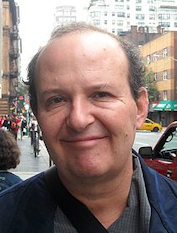
Giulio Prisco is a former Senior Manager in the European Space Agency, a physicist and computer scientist. He served as a member on the board of directors of World Transhumanist Association and continues to serve as a member on the board of directors of the Institute for Ethics and Emerging Technologies and of the Associazione Italiana Transumanisti. He is also a member of the advisory board of the Lifeboat Foundation and a founding member of the Order of Cosmic Engineers and the Turing Church.
-